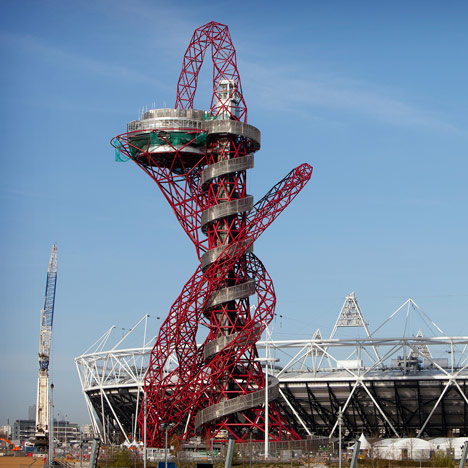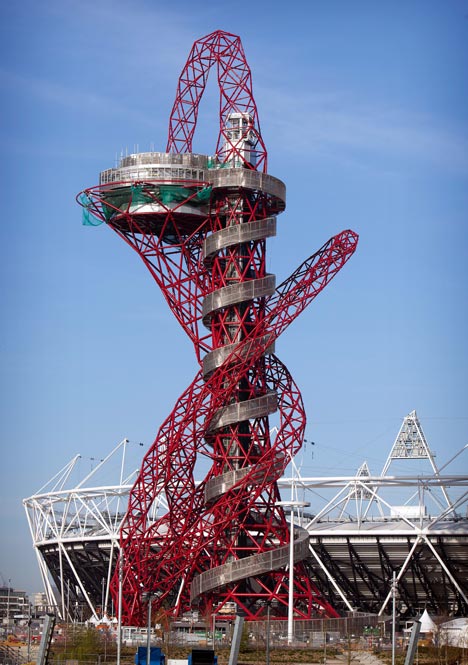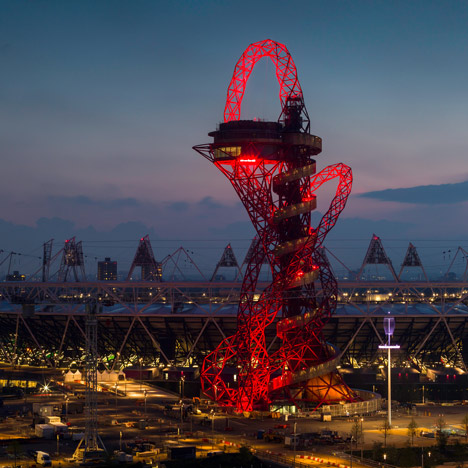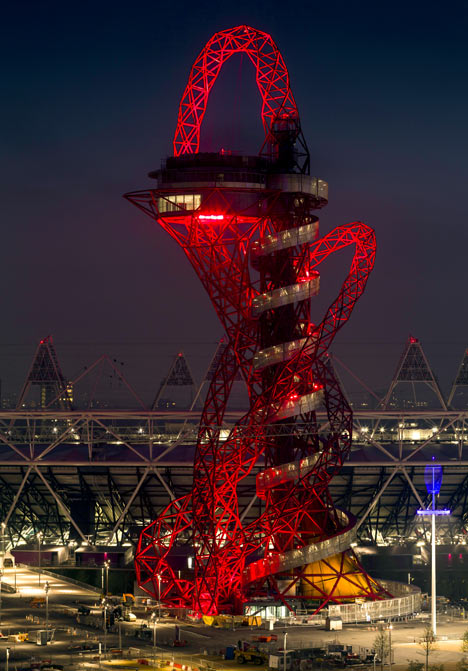
ArcelorMittal Orbit by Anish Kapoor and Cecil Balmond
Construction of the controversial 115 metre-high sculpture that artist Anish Kapoor and structural engineer Cecil Balmond designed for the London 2012 Olympic Park is now complete.

Visitors will enter a central elevator to ascend the steel tower, named the ArcelorMittal Orbit, arriving at an observation deck with a panoramic view of the city. To exit, they will be encouraged to climb down a staircase of 455 steps that spirals around the tower's exterior.

Around 560 metres of red tubular steel form the structure and 250 coloured spotlights illuminate it at night. Internal fit-out will begin later this month and the attraction will open to the public before the games begin in July.

The project suffered a huge backlash when the initial plans were revealed back in 2010. See the comments from Dezeen readers here.
See also: our earlier stories about completed Olympic venues the aquatics centre, the velodrome and the main stadium, and see all our stories about the London 2012 Olympics here.
Photography is by ArcelorMittal.
Here's some more information from the London Mayor's Office:
ArcelorMittal Orbit unveiled to the world
Main construction of the London 2012 landmark is declared complete.
ArcelorMittal, tier two sponsor of the London 2012 Olympic and Paralympic Games and the world’s leading steel company, will today offer a preview of the completed ArcelorMittal Orbit – the 114.5 metre sculpture designed by Anish Kapoor and Cecil Balmond which will stand at the heart of the Olympic Park.
The ArcelorMittal Orbit is being handed over to the London Legacy Development Corporation later this month, so that Balfour Beatty Workplace can complete the fit-out ahead of the London 2012 Games where it will be a ticketed visitor attraction.
The press event will be attended by the team behind the sculpture, including Anish Kapoor and Cecil Balmond, Lakshmi N. Mittal, Chairman and CEO, ArcelorMittal, and Mayor of London, Boris Johnson, alongside the architects, engineers and builders who have helped bring the project to reality. For the first time, attendees to the unveiling will be able to travel up to the viewing platform and enjoy a panoramic view of up to 20 miles, encompassing the entire Olympic Park and London’s skyline beyond. At 114.5m, the ArcelorMittal Orbit is the UK’s tallest sculpture and stands 22 metres taller than New York City’s Statue of Liberty.
“It gives me great pride to see the ArcelorMittal Orbit standing not only as a completed work of public art but as a physical symbol of the Olympic spirit,” comments Lakshmi N. Mittal, Chairman and CEO of ArcelorMittal. “It makes me very proud that ArcelorMittal plants from across the world contributed to this showcase of the strength and versatility of steel,” he adds.
Boris Johnson: “This 114.5metre-high attraction to trump rivals the world over is a calling card for investment in east London. It is a symbol of prosperity and growth, backed by one of the world’s most astute business leaders, which delivers the strongest message that this part of London is open for business after decades of neglect.
“In addition to the £11billion plus investment that has taken place around the Olympics over the last four years, the ArcelorMittal Orbit will draw visitors to newly regenerated swathes of east London in perpetuity and has changed our skyline and aspirations forever. The development of this area, creating new jobs, homes, schools, and thriving communities beyond the Olympics, is one of the most important regeneration priorities as we lay the ground now to meet the needs of the next 25 years.”
Anish Kapoor: “I am absolutely delighted that construction is now complete and I would like to thank the project team for making this possible and for their work on what is technically a very challenging project. I am looking forward to the Olympics when visitors to the Park will be able to go up the ArcelorMittal Orbit for the first time and I am delighted that members of the public will be able to interact with the work in this way.”
Cecil Balmond: “Anish and I were conscious from the beginning that the ArcelorMittal Orbit would be a lasting legacy to the city and so we wanted to stretch the language of the icon as far we could go. The Orbit is a hybrid, a network of art and structure, and its dynamic is the non-linear. You read into it multiple narratives in space.”
One of the world’s leading artists, Turner Prize winning Anish Kapoor studied in London, where he is now based. He is well known for his use of rich pigment and imposing, yet popular works, such as Marsyas, which filled the Tate’s Turbine Hall as part of the Unilever Series, Cloud Gate in Chicago’s Millennium Park and his recent record breaking show at the Royal Academy, the most successful exhibition ever presented by a contemporary artist in London.
The ArcelorMittal Orbit was designed by Anish Kapoor and one of the world’s leading structural designers, Cecil Balmond, who trained and lives in London, and is known for his innovative work on some of the greatest contemporary buildings in the world, such as the CCTV building in Beijing, as well as many Serpentine Gallery Pavilion commissions.
Construction of the ArcelorMittal Orbit took 18 months and required 560 metres of tubular red steel to form the sculpture’s lattice superstructure. The result is a bold statement of public art that is both permanent and sustainable, with close to 60 per cent of the 2,000 tonnes of steel used in the sculpture being drawn from recycled sources, underlining steel’s status as the world’s most recyclable material. Steel was chosen for the ArcelorMittal Orbit because of its unique properties including strength, modular structure and advantages of weight and speed of construction.
Sitting between the Stadium and the Aquatics Centre, the ArcelorMittal Orbit will be a beacon of the Olympic Park during the Games and the Queen Elizabeth Olympic Park as the area will be known after the Games.
Visitors will be able to take a trip to the top of the structure in a lift and down too if they wish, although they will be encouraged to walk down the spiral staircase, which has 455 steps and has been designed to enable the guests to experience the feeling that they are orbiting around the structure as they descend it.
After the Olympic and Paralympic Games and following a period of transformation, the Legacy Corporation will run the ArcelorMittal Orbit as a visitor attraction with ticketed viewing from the observation decks and a compelling venue for private functions. It will be able to accommodate around 5,000 visitors a day with potential to attract around one million people during its first year of operation. It will have the capacity to accommodate between 400 – 600 visitors per hour, including full wheelchair access.
Last month, the Legacy Corporation announced that the ArcelorMittal Orbit will light up East London after 250 colour spot lights were added to the sculpture. Each can be individually controlled to produce a stunning digital combination of static and animated effects including a 15 minute moving light show every evening after the Games.
Andrew Altman, Chief Executive of the London Legacy Development Corporation, said: “The ArcelorMittal Orbit will become one of London’s most spectacular visitor attractions and a stunning backdrop to the Queen Elizabeth Olympic Park. “Not only will it offer differing views by day and night, but it will light up the East London skyline to become a beacon of the incredible transformation of this part of East London.”
The Legacy Corporation, which will lease the ArcelorMittal Orbit to LOCOG during the Games, has said that 85% of the 50 jobs created in the venue after the Games will go to local people.
As a tier two sponsor of London 2012, ArcelorMittal has committed to funding up to £19.6 million of the £22.7 million cost of the ArcelorMittal Orbit, with the outstanding £3.1 million provided by the London Development Agency. It has been estimated that the resulting visitor attraction will generate up to £10 million of revenue per annum and create up to 50 new jobs following the 2012 Olympic and Paralympic Games.